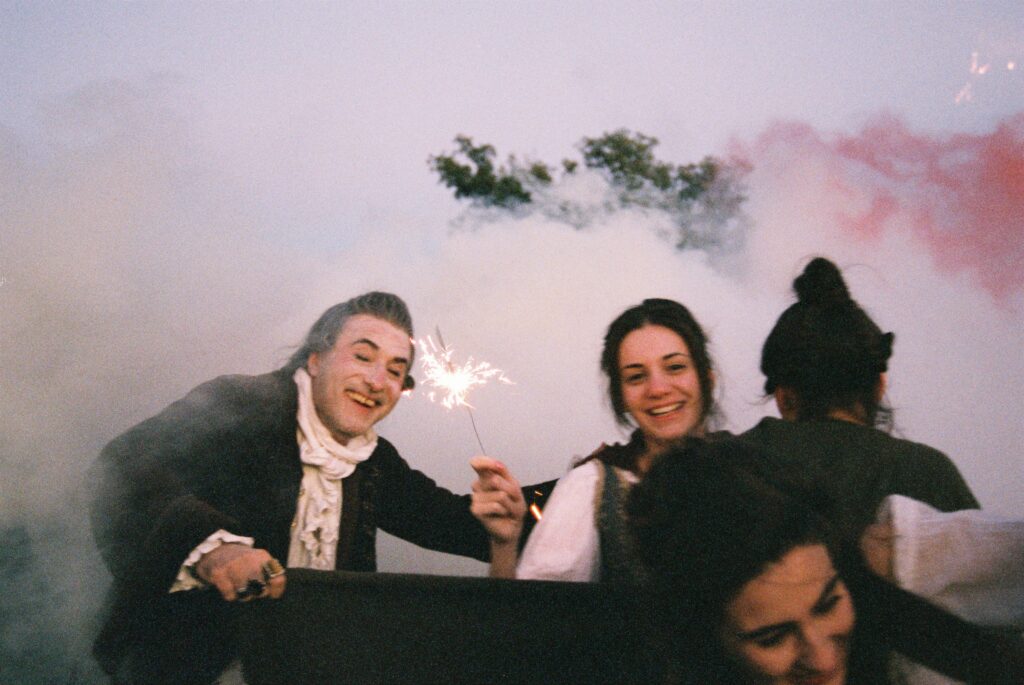Casanova, that notorious 18th-century lady-killer, ravenously consumes food during every one of Story of My Death’s first several scenes. Shortly thereafter, he defecates it all out in a bowl in his room and giggles at the sight of the steaming pile. Later, in a remarkably unfunny money shot (literally), another mound of his shit performs a Méliès-like transformation before our very eyes into shimmering gold. Add carnal sex to the mix and Albert Serra’s new film completes a holy trinity of bodily taboos rarely seen in costume dramas. Aristocrats are animals too! A trenchant insight indeed.
For Serra, such low-level “subversion” qualifies as a means with which to shock the audience’s sanitized perceptions of old European royalty, so Story of My Death never bothers to evolve beyond these scatological effronteries. But the crude twisting of expectations doesn’t end here: The film’s very title is an inversion of Casanova’s famous memoir Story of My Life, the tedious preparation of which Serra loosely dramatizes for the first hour; and when Dracula shows up for the home stretch, it’s a dubious left-field attempt to collide an Enlightened sensibility with primordial darkness, historical record with mythic imagination. Casanova’s jet-black European contemporary brings with him a wave of blood and perversity to further add to the dismaying sense that, in addition to unloading all varieties of bodily fluids, Serra’s primary interest lies in the mere presence of dialectics, as if profundity’s a self-evident byproduct of putting shiny vases next to peeing women.
Granted, Story of My Death’s central philosophical construct — namely, that human nature is always on a turnstile between rationality and animal instinct — is fertile and worth exploring. Indeed, it’s the axis on which Serra’s structure pivots, moving as it does over two-and-a-half hours from the wordy discourse of Casanova’s countryside manor to the wordless horror of Dracula’s Carpathian woodlands. But ultimately it’s the filmmaking itself, not the ideas ostensibly being explored, which strands this willfully esoteric dress-up show from any sense of heft or cinematic vitality. Those familiar with the Catalan filmmaker’s work will recognize Story of My Death’s long-winded scenes and inflexible static shots as auteurist tics (though, to be sure, he’s hardly a game-changer in this regard), but here they register as mere affectation. Serra has his own reasons for indulging the air-sucking inertness of a non-actor like Lluís Serrat (playing Casanova’s servant) for minutes on end (and he’ll blow a lot of hot air about those reasons in the press, too), but it would seem to take heroic levels of sensitivity to the unseen world to see anything more than atmospheric filler in a scene of Serrat staring at the ground while listening to his boss tell him for the hundredth time that “all women are the same.”
Serra’s primary interest lies in the mere presence of dialectics, as if profundity’s a self-evident byproduct of putting shiny vases next to peeing women.
Most damningly for a film so clearly in pursuit of dreamlike illogic, Serra fails wholly as an image-maker. That cinematographer Jimmy Gimferrer’s work in Story of My Death (principal photography apparently yielded over 400 hours of semi-improvised footage) has been speciously compared to Caravaggio’s canvases is an insult to Caravaggio. Allegedly framed in 4:3 but re-sized for widescreen in post-production and bearing all the compositional inelegance that such an approach would imply, the film looks to have only incorporated the bare minimum of artificial lighting, in many cases using none at all — an admirable gamble when you have a genuine wizard like Emmanuel Lubezki on your team, but a foolhardy and arbitrary aesthetic handicap in this case. Most of Story of My Death suffers from pictorial flatness: Figures are rarely separated from the background because there are so little gradations of exposure, an issue that becomes doubly disastrous when Serra shifts unit entirely to the nocturnal forest. When the film delivers what are seemingly its most crucial narrative incidents in that forest, all you can see are vague blobs of flesh bobbing around indistinguishably in inky darkness, someone’s bloody neck occasionally surfacing from the overwhelming shadow.
Conceptually speaking, this pictorial murkiness might be justified by Story of My Death’s dive from the jolly afternoon philosophizing of Casanova’s world to Dracula’s serpentine abyss — but only on the most rudimentary level. What matters is that Serra’s egotistical production methods leave little room for the audience; his cinema lies well past the threshold where personal ambition tips over into noodly abstraction. Story of My Death’s best moments shift its director’s gall to the background in favor of simple sensory immersion into mundane happenings before the camera — such as an early study of two engorged lovers drifting off after a candlelit dinner, or perhaps the multiple still lives of roasting animal heads. Set to striking, underused snatches of an electroacoustic score, these moments suggest a more humbling, streamlined movie than this fraud filmmaker would let slip from his overconfident grasp.

